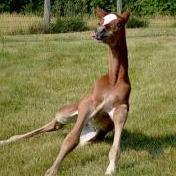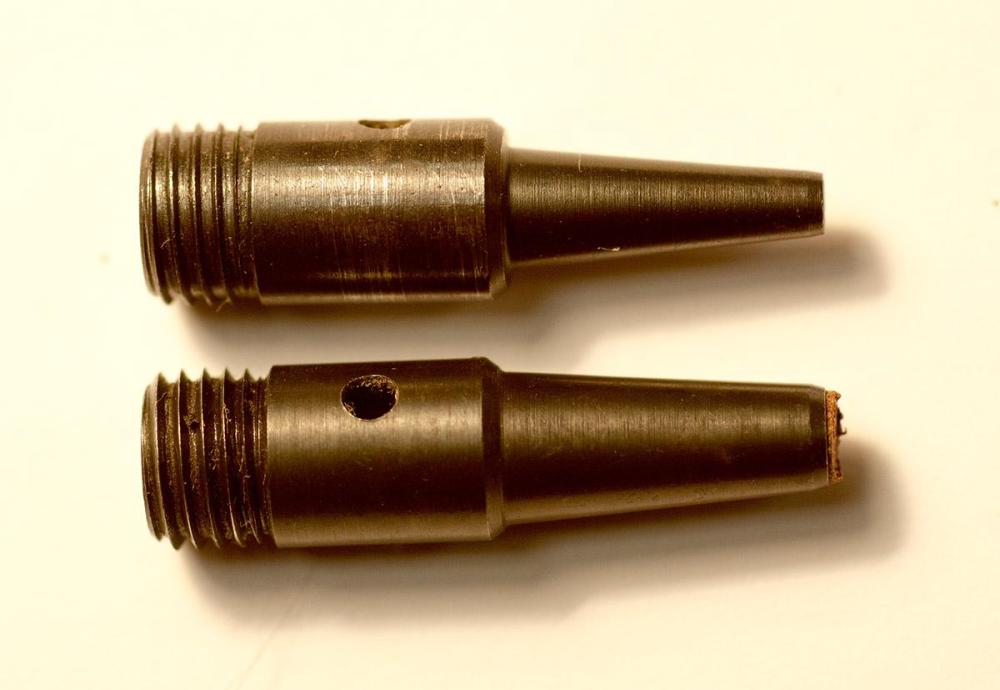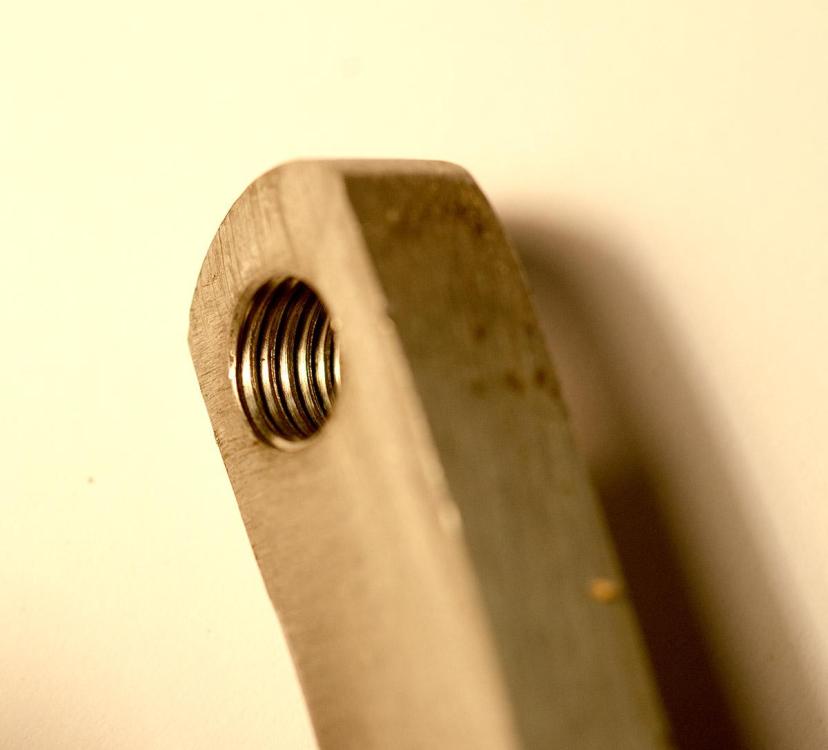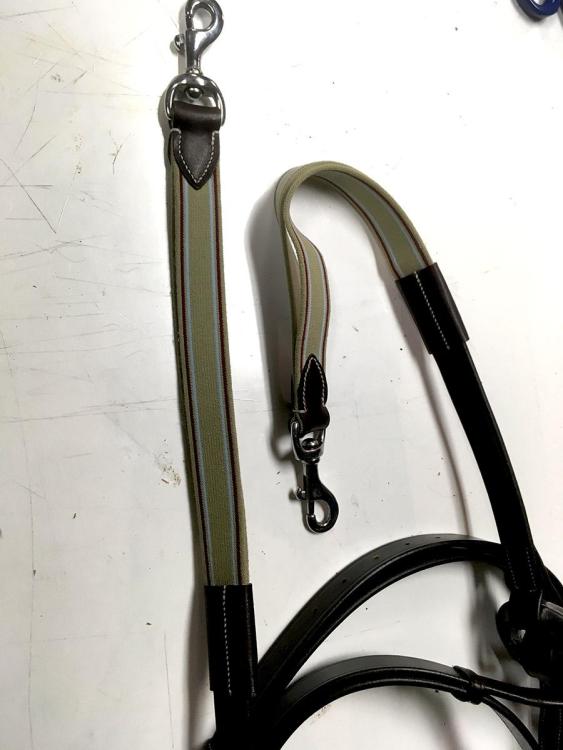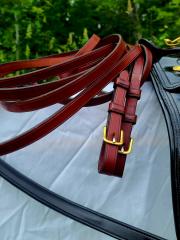-
Posts
1,282 -
Joined
-
Last visited
Content Type
Profiles
Forums
Events
Blogs
Gallery
Everything posted by TomE
-
Thanks, Bruce. The tubes that screw easily into my frame appear to have the taller thread. In the picture below, the tube that fits is on the bottom and the tube that doesn't screw in is on the top. The frame was purchased about 4? years ago with a set of tubes that fit the frame. In 2022 I purchased a size #0 and #00 tube from Springfield Leather. The #00 fits my frame, and the #0 shown here does not fit. Perhaps the size #0 tube is the older style and everything else I have is the newer style? Here is a picture of the frame. The threads appear rough and flat, like they're not cut in fully. CSO didn't respond to my question about what size tap I should use to chase the threads. I sent them my frame and punch tubes as requested. I'll report back on what they return to me. I will try the steel wool polishing tip. Not sure if I can make an effective Q-tip small enough for the #0 and #00 tubes. Turns out that the #0 is my favorite size for stamped steel bridle buckles.
-
Do you recall when I was trying to rethread a hardened Osborne punch tube and you advised me about annealing, heat treating, and tempering? Worked great, except the inside of the tube developed scale(?) and tends to clog. I've tried polishing inside using a thread coated with compound but maybe haven't tried enough. Bruce Johnson recommended tapping out the punch frame to fix this mismatch of old and new Osborne punch tubes. This is a spring punch that holds a single tube. Finally got back to this project and called CSO to ask what size tap I should use. Their "technician" replied that I should just send in the frame and tubes. So I'm waiting to see what they come up with.
-
When you make a made-to-measure item based on the client's measurements then the client decides that the original item they took the measurements from wasn't a good fit after all.
-
I think the idea is to add enough baking soda to produce CO2 bubbles without neutralizing the acidic vinegar. So if you believe in scrubbing bubbles you can still get the benefits of the acid. Not my choice for metal parts.
-
Looking forward to it. Congratulations to Gustav! What an honor to be chosen by von Rönne. An experience of a lifetime.
-
Thank you kindly, @Mulesaw. Glad it was useful. I'm hoping to get more time for leathercraft in the coming months. The heat and humidity have kept us busy, changing our turnout routine and hosing off mares and foals that are hot. Cooler weather this week should make everyone happy.
-
Here I doubled up on 1" heavy elastic for these side reins. Abbey England sells this in a variety of widths including 2". For equine tack, the ends of the elastic are typically sandwiched between leather or nylon webbing chapes. These side reins attach to the bit and to the saddle and are used to maintain head position (with some give from the elastic) while working the horse from the ground.
-
The buckles of an English girth attach to the leather girth with a short piece of heavy elastic.
-
The best elastic that I've used for horse tack is sold by Abbey England. It is used on girth straps, side reins, and other items that see a lot of wear and tear.
-
Agree with @fredk. I would pre-punch the holes in the leather then sew with a harness needle to pierce the elastic without cutting the threads. The single needle backstitch that Fred refers to is a good choice for sewing woven fabric/webbing to leather. The overlapping stitches on the fabric side skip a hole and gather more threads in each stitch. This method is used to sew billets/girth straps to the webs of an English saddle to distribute the load on the webbing. This video shows backstitching for making a leather loop/keeper. The inside of the loop with overlapping, double length stitches would correspond to the elastic side of your project.
-
I'll put in a plug for PVA glue (Elmer's white glue). It is water soluble and doesn't interfere with burnishing edges of glued projects. It also allows realignment of pieces before the glue dries when needed. I use contact cement for most projects, but the white glue can be useful at times.
-
This thread may help.
-
@Uwe has produced some very informative videos that helped me understand and tame my 441 clone. This is my favorite for timing a TSC-441 type machine.
- 6 replies
-
- cowboy4500
- needle strike
-
(and 1 more)
Tagged with:
-
Welcome! I'm in Villa Ridge and travel regularly to Springfield Leather to pick out hides that were tanned in Saint Louis (Hermann Leather Co). We have some great local resources for crafters. Hope you enjoy this forum as much as I have and wishing you well. Look forward to seeing some of your sheaths.
-
Diamond hones with an elliptical profile work well on curved blades. They are sold by farrier supply houses for sharpening hoof knives. I've had good luck with the Mustad hone shown on this page, and the FPD (Farrier Products Distribution) brand is also typically good quality tools. https://www.farriersdepot.com/tools/knives/sharpener/
-
I have an old Tandy Pro splitter that is a knockoff of the #84. For lap skives of strap ends the pressure/setting needed varies a bit with the type of leather and the condition of the blade. Another big factor is the angle of the strap passing over the blade. I pull the strap at a consistent angle and for constant thickness splits I have a finger on top of the strap entering the splitter to guide it. This finger helps compensate for variable stiffness that changes the bend of the leather passing over the roller. For lap skives I mainly judge by watching the split as I go, and practicing on scraps. I begin the skive at the edge of the bag/crew punch hole and ease the pressure slightly before finishing the split down to about 2 oz thickness. I split conservatively and touch up the end with a round knife if needed. I avoid thinning the actual buckle turn where the tongue is inserted unless the buckle needs more clearance. It is mostly by feel and watching the split.
-
Similar to what @chuck123wapati said, Stohlman describes a wood and leather insert for golf clubs (Case Making vol. 3). It's a piece of 1/4" plywood covered with leather and wrapped in a leather collar that fits inside the top of the golf bag so the insert is recessed ~2" from the top. The leather collar is glued and tacked to the edge of the plywood and the assembly is inserted in the bag and sewn in place. Forgot to mention that the insert has holes for the clubs.
-
This looks similar to the iSTOR sharpener that I posted a question about. It’s hard steel that is drawn across the edge of a blade to shape and sharpen. Seems to work well for profiling the edge.
-
So Tandy makes alphabet Craftaids, which are plastic templates to transfer a design to cased leather. I used them as a kid (before desktop computers). Now I just create the design in illustrator, print it out, and transfer to leather by tracing the design.
-
Can buy 1/2" rubber stall mats at farm stores. They won't have tire tread but typically one side is textured and the other might have shallow grooves (to channel pee). They're not hard to cut, at least in a straight line, using a sharp utility knife. I usually put a scrap of plywood under the mat next to the cut line so I can bend the rubber slightly and remove pressure/friction from the blade.
-
Hide House https://www.hidehouse.com/ has lots of chrome tanned leathers. They could advise you on type and weight of leather for your project.
-
Very pretty machines. They look like museum pieces. What is the blue finish?
-
Agree with @ArkieNewbie that pulling on the bobbin thread should turn the bobbin clockwise. Here's an unofficial Class 26 manual that I scrounged on the internet. Class 26 Manual.pdf There's good information on this forum for the similar Pfaff 145 machine. Searching for "Juki 341" (in quotes) turns up this and other threads. I think changing needle size might help you sort out tension, as LMC recommended. Check for any flagging and adjust pressor foot tension as needed.
-
Seems likely that the keeper is stretched out of shape or the stitching holes are torn out. I would make a new keeper and resew both sides of the buckle turn using the old holes. Need an awl to make holes in the keeper once it’s sandwiched between the layers of the turn. Angle the awl to sew the second side of the keeper. Here’s the method.
-



